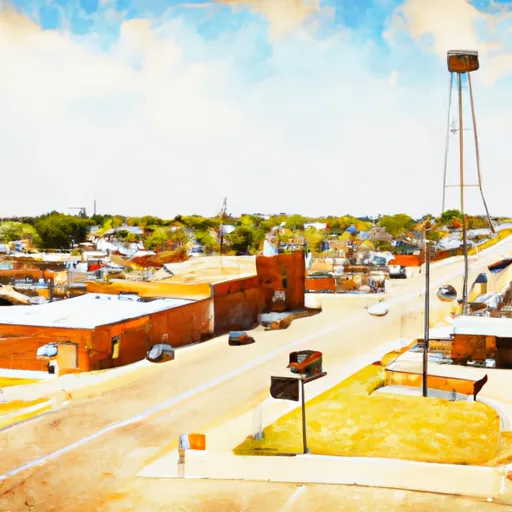-
 Snoflo Premium
Snoflo Premium
Get unlimited access to all our content
With no Ad interruptions! - Start Your Free Trial Login with existing account
Quanah
Eden Index
Climate
8.1
•
Recreation
1.4
•
Community
2.7
•
Safeguard
4.4/10

Quanah is a small city located in the northern part of Texas, near the Red River. The climate in Quanah is considered to be a semi-arid type, with hot summers and mild winters. Summers are characterized by high temperatures, reaching an average of around 95°F (35°C), while winters are relatively mild with temperatures around 55°F (13°C). The region receives an average annual precipitation of about 23 inches, with the majority occurring during the summer months.
Quanah benefits from the presence of several hydrology constituents, including the Red River, which runs along its northern border. The river provides a water source for the city and supports various recreational activities such as fishing and boating. Additionally, there are several creeks and reservoirs in the area, contributing to the hydrological makeup of Quanah.
For outdoor enthusiasts, Quanah offers several recreational opportunities. The Copper Breaks State Park, situated just west of the city, provides visitors with opportunities for hiking, camping, and wildlife observation. The park is known for its unique red rock formations and offers scenic views of the surrounding landscape. Moreover, the area around Quanah is known for its excellent hunting opportunities, with deer and turkey being popular game species.
In conclusion, Quanah, Texas, boasts a semi-arid climate, with hot summers and mild winters. The city benefits from hydrology constituents such as the Red River and offers various outdoor recreation opportunities, including fishing, boating, hiking, camping, and hunting.
What is the Eden Index?
The Snoflo Eden Index serves as a comprehensive rating system for regions, evaluating their desirability through a holistic assessment of climate health, outdoor recreation opportunities, and natural disaster risk, acknowledging the profound impact of these factors on livability and well-being.
Climate Health Indicator (CHI): 8.1
Quanah receives approximately
648mm of rain per year,
with humidity levels near 84%
and air temperatures averaging around
17°C.
Quanah has a plant hardyness factor of
7, meaning
plants and agriculture in this region tend to thrive during the non-winter months.
By considering the ideal temperature range, reliable water supplies, clean air, and stable seasonal rain or snowpacks, the Climate Health Indicator (CHI) underscores the significance of a healthy climate as the foundation for quality living.
A healthy climate is paramount for ensuring a high quality of life and livability in a region, fostering both physical well-being and environmental harmony. This can be characterized by ideal temperatures, reliable access to water supplies, clean air, and consistent seasonal rain or snowpacks.
Weather Forecast
Streamflow Conditions
Red-Pease
Area Rivers
Red-Pease
Snowpack Depths
Red-Pease
Reservoir Storage Capacity
Red-Pease
Groundwater Levels
Recreational Opportunity Index (ROI): 1.4
The Recreational Opportunity Index (ROI) recognizes the value of outdoor recreational options, such as parks, hiking trails, camping sites, and fishing spots, while acknowledging that climate plays a pivotal role in ensuring the comfort and consistency of these experiences.
Access to outdoor recreational opportunities, encompassing activities such as parks, hiking, camping, and fishing, is crucial for overall well-being, and the climate plays a pivotal role in enabling and enhancing these experiences, ensuring that individuals can engage in nature-based activities comfortably and consistently.
Camping Areas
| Campground | Campsites | Reservations | Toilets | Showers | Elevation |
|---|---|---|---|---|---|
| Haskell City Park | 10 | 1,575 ft | |||
| Copper Breaks State Park | 35 | 1,462 ft | |||
| Sayre City Park | 80 | 1,799 ft |
Nearby Fishing
Nearby Ski Areas
Catastrophe Safeguard Index (CSI):
The Catastrophe Safeguard Index (CSI) recognizes that natural disaster risk, encompassing floods, fires, hurricanes, and tornadoes, can drastically affect safety and the overall appeal of an area.
The level of natural disaster risk in a region significantly affects safety and the overall livability, with climate change amplifying these risks by potentially increasing the frequency and intensity of events like floods, fires, hurricanes, and tornadoes, thereby posing substantial challenges to community resilience and well-being.
Community Resilience Indicator (CRI): 2.7
The Community Resilience Indicator (CRI) recognizes that education, healthcare, and socioeconomics are crucial to the well-being of a region. The CRI acknowledges the profound impact of these elements on residents' overall quality of life. By evaluating educational resources, healthcare accessibility, and economic inclusivity, the index captures the essential aspects that contribute to a thriving community, fostering resident satisfaction, equity, and social cohesion.

